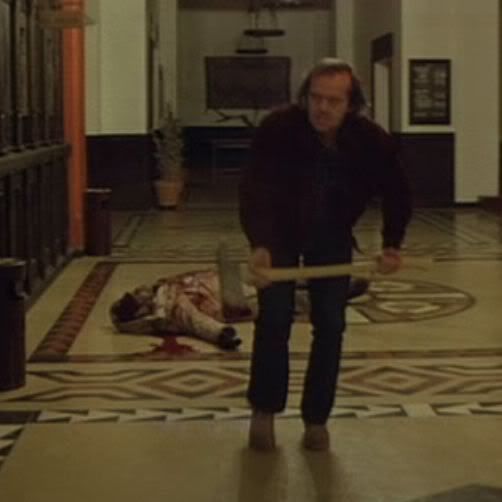The narrative structure theorists are Propp, Todorov, Strauss and Broadwell & Thompson.
Propp holds the theory that in folk stories there are 8 identifiable character roles and 31 narrative functions, altough these may not all fit into a story at once there should be most within the narrative. In The Shinning there are 7 of 8 of the character roles although they are unclear.
Propp holds the theory that in folk stories there are 8 identifiable character roles and 31 narrative functions, altough these may not all fit into a story at once there should be most within the narrative. In The Shinning there are 7 of 8 of the character roles although they are unclear.
2) The Hero - Danny/Wendy
3) The Donor - Dick Hallorann
4) The Helper - Dick Hallorann
5) The Princess - The Snow Cat
6) Her Father - N/A
7) The Dispatcher - The Hotel Manager
8) The False Hero - Jack
His 31 Narrative functions which fit with the narrative structure and allow us to think more about the story of The Shinning. But not so much 21-30.
Todorov: He came up with two diagrams to describe the narrative structure of a story, which he discovered could be use for most stories.
both of his structures fit the plot of the shining where there is a equilibrium which is disturbed then there is struggle to a new better equilibrium. but there is no real closure from the film but it does allow to keep a structure.
To begin there is equilibrium with jack looking for a job, then the crisis happens when they go to the hotel and Jack goes crazy, then they reach a new equilibrium when they escape the hotel.
 Strauss: Strauss uses the idea of binary opposition, meaning having two opposites going against each other, good and evil (Danny and Jack) Sane and Insane (Jack and Sane Jack) Past and Present (Jack and Delbert) its not always a definite yes or no answer, somethings are left un answered. the benefits of this is that it shows us a clear sense of good and evil in the story.
Strauss: Strauss uses the idea of binary opposition, meaning having two opposites going against each other, good and evil (Danny and Jack) Sane and Insane (Jack and Sane Jack) Past and Present (Jack and Delbert) its not always a definite yes or no answer, somethings are left un answered. the benefits of this is that it shows us a clear sense of good and evil in the story.
Broadwell and Thomas: they said that when watching a film the audience tries to connect to the event to make sense of the situation. connected with this is the kuleshov experiment. the idea behind this is that audiences have there own ideas about how the film works and that is how we join pieces together which is aided by continuity editing. and the director can control the emotion with camera movement and editing types. In the Shining this is used when we see Danny on his trike and he sees the twins and the camera switches between them Danny and them dead, creating emotion and tension.
Todorov: He came up with two diagrams to describe the narrative structure of a story, which he discovered could be use for most stories.
both of his structures fit the plot of the shining where there is a equilibrium which is disturbed then there is struggle to a new better equilibrium. but there is no real closure from the film but it does allow to keep a structure.
To begin there is equilibrium with jack looking for a job, then the crisis happens when they go to the hotel and Jack goes crazy, then they reach a new equilibrium when they escape the hotel.
 Strauss: Strauss uses the idea of binary opposition, meaning having two opposites going against each other, good and evil (Danny and Jack) Sane and Insane (Jack and Sane Jack) Past and Present (Jack and Delbert) its not always a definite yes or no answer, somethings are left un answered. the benefits of this is that it shows us a clear sense of good and evil in the story.
Strauss: Strauss uses the idea of binary opposition, meaning having two opposites going against each other, good and evil (Danny and Jack) Sane and Insane (Jack and Sane Jack) Past and Present (Jack and Delbert) its not always a definite yes or no answer, somethings are left un answered. the benefits of this is that it shows us a clear sense of good and evil in the story.Broadwell and Thomas: they said that when watching a film the audience tries to connect to the event to make sense of the situation. connected with this is the kuleshov experiment. the idea behind this is that audiences have there own ideas about how the film works and that is how we join pieces together which is aided by continuity editing. and the director can control the emotion with camera movement and editing types. In the Shining this is used when we see Danny on his trike and he sees the twins and the camera switches between them Danny and them dead, creating emotion and tension.




Some good points Harry, but:
ReplyDelete1. Please correct "theories" spelling in the title.
2. Todorov - the diagrams are not his - they are my way of expressing his ideas. His theory was basically about equilibrium/disequalibrium/new equilibrium.
3. Bordwell and Tompson have some intersting ideas about time in a film text which you could explore a little.